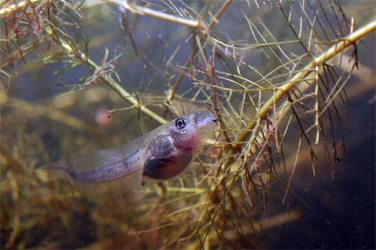Recent studies suggest that direct mortality and physiological effects caused by pollutants are major contributing factors to global amphibian decline. This study shows how sublethal concentrations of pollutants can disrupt the ability of amphibian larvae to recognize their natural predators, hence increasing the risk of predation in the populations. This indirect effect is indeed much more important since very low amounts of pollutants are ubiquitous, and environmental efforts are mostly directed towards preventing lethal spills. Researches have compared the swimming activity of tadpoles of the western spadefoot toad, Pelobates cultripes, in the presence and absence of water-borne chemical cues from a common predator –nymphs of the dragonfly Anax imperator–, at different concentrations of two contaminants present in natural waters: humic acid and ammonium nitrate. Tadpoles reduced swimming activity in response to predator cues in the absence of pollutants, whereas they remained unresponsive to these cues when either humic acid or ammonium nitrate was added to the water, even at low concentrations. Alteration of the natural chemical environment of aquatic systems by pollutants may represent a serious threat for amphibian populations. informacion[at]ebd.csic.es Polo-Cavia et el (2016) Low levels of chemical anthropogenic pollution may threaten amphibians by impairing predator recognition Aquat Toxicol 172: 30-35 doi:10.1016/j.aquatox.2015.12.019
http://www.sciencedirect.com/science/article/pii/S0166445X1530134X

 Las altas temperaturas están provocando que las lagunas y las marismas de Doñana pierdan agua rápidamente
Las altas temperaturas están provocando que las lagunas y las marismas de Doñana pierdan agua rápidamente




